 Author: Paul “BJ” Ransbury, Chief Executive Officer
Author: Paul “BJ” Ransbury, Chief Executive Officer
7 X Master CFI-Aerobatic / CFI / CFII / MEI / AGI
Former Part 141 Chief Flight Instructor
Airbus A320 Pilot, F/A-18 Hornet Fighter Pilot
Fighter Weapons Instructor Course (FWIC) Graduate
ICAS-Certified Air Show Performer
Contact Us to learn more about Upset Prevention & Recovery Training
TABLE OF CONTENTS:
- Introduction
- Understanding Angle of Attack
- Significance of AOA in Upset Recovery Situations
- Beyond Critical Angle of Attack
- AOA Management in All Upsets
- How Can We Ensure AOA Remains Below Critical
- Stall Warning Devices
- Recovery Technique Development
Introduction
How exactly do you put your finger on the single most important aerodynamic component or practice related to Upset Prevention & Recovery Training (UPRT)? That’s a tough question and, quite honestly, the answer varies depending upon the situation being addressed. As opposed to picking “one” aerodynamic component as “the” critical factor in upset recoveries, a thorough discussion of recovery techniques must focus on the order in which control loss issues are addressed for a generalized recovery to be effective in a wide variety of instances.
In this article we are going to focus on the first action step in recoveries which involves Angle of Attack Management as a top priority in a generalized recovery philosophy.
There really are only five major aspects of flight that pilots have direct control over while airborne in a time-critical upset emergency flight condition. They are (in no particular order):
- Pitch
- Roll
- Yaw
- Power, and
- Configuration
Although a seemingly simple list of items to be managed, not only are they usually mismanaged in an emergency unusual attitude scenario, but they are also typically addressed in the wrong order and in the opposite direction assuming the ultimate goal is an effective, efficient and successful recovery. This is why when you’re reading articles on stall/spin, unusual attitude or upset recovery training techniques, you’ll hear the author state time and again that the recovery is counter-intuitive.

Our formal research at APS indicates an alarming 90% of pilots without previous upset recovery experience “pull” when faced with an overbank situation beyond 90 degrees of bank. Let’s not let breeze by the significance of this statistic … that means without training a full 9 out of 10 pilots, regardless of experience level from PPL to ATP, will most likely pull into the ground in a wake turbulence upset or cross-controlled stall when faced with the situation for the first time. This intimidating statistic might be even worse in the non-training environment! In our formal research, the pilots being evaluated have recently received (within 24 hours) a full two hours of ground training explaining the proper all-attitude recovery and have been told specifically not to pull in an overbank. This should affirm to all pilots that reliable piloting capability to recover from an in-flight upset or unusual attitude can only be gained through extensive hands-on practical experience in real aircraft complimented by highly specialized ground training. Simply put, no amount of academic training can prepare a pilot to consistently and effectively deal with an in-flight upset situation beyond their normal experience.
How about simulator training – does that have value? Absolutely. However, as any simulator manufacturer will tell you, the simulator has a narrow high-fidelity flight envelope that will accurately represent what the real aircraft will do or how it will respond in flight. For operations within the envelope modeled by the simulator, the simulator is close to flawless. Outside the envelope encompassing the pilot’s “normal experience” flight parameters and the simulator’s programming, the simulator is just guessing and is, to date, unable to accurately model stalled flight and stall recovery effectiveness. Simulator training is invaluable, however one must recognize that the vast majority of aircraft upsets and stalled flight conditions occur beyond the simulator’s programmed high-fidelity envelope.
For the purposes of this discussion, we define “normal experience” as flight attitudes of less than 30 degrees of pitch relative to the horizon and within 60 degrees of bank for GA pilots. By the way, to all my fellow ATPs and airline pilots out there, don’t scoff too heartily at this seemingly insignificant “normal experience” margin for GA pilots. For you, an upset as defined in the FAA Airplane Upset Recovery Training Aid – Revision 1 is even smaller: 25 degrees nose-up, 10 degrees nose down and less than 45 degrees of bank. Why? Because if you’re like the vast majority of professional pilots, more than 99.999% of your professional air carrier flight experience is within these even narrower flight attitude margins.
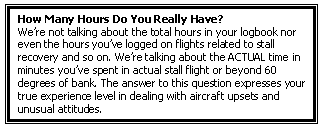
A perspective building question at this point to open our minds is: “How many hours have you personally logged in actual stalled flight or physically beyond 60 degrees of bank in a real aircraft?”. We’re not talking about the hours you’ve logged on flights related to stall recovery and so on, we’re talking about the ACTUAL time spent in these extreme conditions. The answer to this question expresses a pilot’s true experience level in dealing with aircraft upsets and unusual attitudes. Unfortunately, the instinctual piloting skills learned and mastered in normal flight are not reliably transferable to the unusual attitude flight regime. Most 20,000 hour pilots will respond having somewhere between 3 and 10 minutes of actual time spent in these extreme flight regimes. Sometimes it’s as low as 30 seconds to a minute. Most would agree there is an enormous difference between 10 minutes and 20,000 hours. If not, just think how competent a pilot is in landing an aircraft after 10 minutes of flight instruction. Scary, isn’t it? Ok, let’s start the learning process with a discussion on Angle of Attack and its significance in upset recovery training.
Understanding Angle of Attack
Angle of Attack or “AOA” as we like to call it in pilot techno-speak, is a very straightforward concept that each and every one of us learned during basic flight training. Simply put, the AOA of a wing is the angle between the relative wind and a reference line, typically the chord line of the airfoil. The AOA reference line can be the wing’s overall average chord line or a line relative to or parallel to the aircraft’s longitudinal axis or fuselage boreline. Regardless of the line used, the AOA is the angle between the designated reference line and the relative wind or velocity vector representing the aircraft’s trajectory through the air. Pictorially, they are represented below:

Figure 2: Airfoil at Angle of Attack[1]
Figure 3: Lift at Angle of Attack[2]
By definition, Critical AOA (AOAC) occurs at the peak of the lift curve in Figure 2. This peak additionally represents the angle of attack producing the maximum coefficient of lift (CL). As we go beyond this aerodynamic limit and into stalled flight characterized by boundary layer separation from the wing, the physics of flight change as the trend of the lift curve reverses to a negative gradient beyond critical angle of attack (more on this later in the section titled “Beyond Critical AOA”). The significance of the reversal of the lift curve remains under emphasized in traditional flight training. This simple reversal dramatically changes the flight characteristics of the aircraft beyond this point resulting in aircraft handling characteristics that are completely different from those we are accustom in the normal flight envelope (ie. AOA less than Critical AOA). Bottom line, the physics of flight change beyond AOAC.
 With all that said, the concept of AOA is simple with no mysteries. Unfortunately, AOA is one of the most mismanaged and misunderstood aspects of aerodynamics, especially in an unusual attitude situation. In the world of upset recovery paradigms, we all need to understand that “AOA is Life”. With only a few exceptions, in all non-spin upset scenarios we must first and foremost effectively manage angle of attack to optimize our survivability regardless of our airspeed, angle of attack or flight attitude. If we ignore AOA management during any stage of the recovery, we can potentially find ourselves in a world governed by different aerodynamic characteristics.
With all that said, the concept of AOA is simple with no mysteries. Unfortunately, AOA is one of the most mismanaged and misunderstood aspects of aerodynamics, especially in an unusual attitude situation. In the world of upset recovery paradigms, we all need to understand that “AOA is Life”. With only a few exceptions, in all non-spin upset scenarios we must first and foremost effectively manage angle of attack to optimize our survivability regardless of our airspeed, angle of attack or flight attitude. If we ignore AOA management during any stage of the recovery, we can potentially find ourselves in a world governed by different aerodynamic characteristics.
Significance of AOA in Upset Recovery Situations
Angle of attack is often erroneously paired with “Pitch Angle” in hangar talk. Although Pitch can be defined as “movement about the lateral axis”[3], a high nose-up Pitch attitude is not necessarily related to the aircraft’s angle of attack. Following this logic, if we define the Pitch Attitude as the angle between the longitudinal axis of the aircraft and the horizon, then it is important to emphasize that AOA is NOT the same as our Pitch Attitude nor is it the same as the aircraft’s Deck Angle in airline-speak. As we can see from Figure 4 below, our angle of attack is smaller in this case.
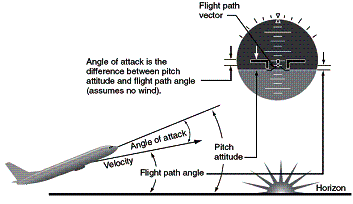
Figure 4: Pitch Attitude, Flight Path Angle and Angle of Attack[4]
Although seemingly similar in day-to-day flight operations, in an upset situation (especially in a stall), we must clearly understand that our angle of attack, which should be demanding immediate pilot attention, is a function of what we as the pilot or the autopilot/autotrim system is doing with the elevator control in the cockpit. It is not related to airspeed nor is it related to our flight attitude.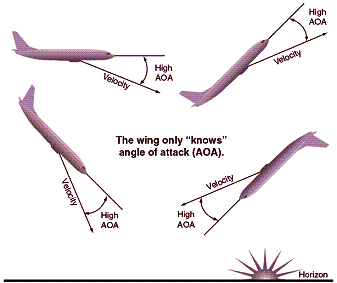
Figure 5: Several Pitch Attitudes at Stall Angle of Attack[5]
For clarification, Figure 5 above clearly shows that stalled AOA can occur in any flight attitude. In an unexpected stall near the ground, the fatal instinctual response of the panicking pilot is commonly an aggressive pull back on the control column to try to gain altitude even when inverted. This instinctual pull perpetuates the out-of-control situation and could, if left unchecked, progress quickly from the stall into the incipient spin and finally, if sufficient altitude exists, an unrecoverable fully developed spin.
Scenarios: The panic “pull” response can be disastrous in a nose-low stall on approach, a wake turbulence upset, any overbank or even from an uncoordinated stalled turn in the traffic pattern. Is that surprising that a common pilot response in these situations is to pull back? It might seem surprising as we leisurely read this article, however, keep in mind that 99.999% of the time: “pulling” equals “up”, right? Right – but not in this situation. As outlined in the introduction, statistically over 90% pilots without proper upset recovery training when faced with their first scenario-based overbank situation beyond 90 degrees. “Scenario-based” simply means that the situation is introduced in an real-life scenario when the pilot’s mind is on another task like flying a simulated approach or performing a simulated turn in the traffic pattern while trying to tighten their turn radius to a centerline overshoot from base-to-final.
The significance of AOA remaining beyond Critical AOA is that, generally speaking, the longer an aircraft remains in a stall, or worse, the stall is allowed to couple with uncorrected yaw, the more likely the development of an unrecoverable spin. This is especially true in large aircraft with wing-mounted or fuselage mounted engines. For more information on the Risk of Spinning Normal Category Aircraft visit the APSTraining.com website.
The key to success in avoiding the spin is stall recognition and avoidance. Let’s be more precise with this statement: The key to success in avoiding a stall/spin accident is Angle of Attack Awareness. Aircraft don’t spin on their own, pilot’s spin aircraft. The path to a developed spin is not passive. It requires aft elevator input from the pilot, or autopilot, combined with yaw to get there.
Beyond Critical Angle of Attack
In stalled flight, we simply cannot do anything else effectively until we first regain control of the aircraft by reducing angle of attack back to the normal flight envelope. Remember we talked about the number of hours the typical pilot has logged in stalled flight? Keep in mind that despite hundreds, thousands or even 10s of thousands of hours of normal flight envelope experience, we are now operating in a regime where the physics of flight beyond Critical Angle of Attack are different.
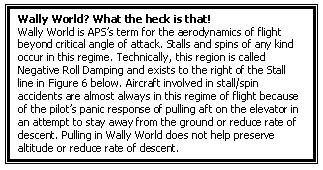
For those readers who have had the chilling opportunity to listen to the cockpit voice recorder from a fatal stall/spin accident, quite often the pilots will be discussing what is wrong with the aircraft’s handling characteristics. Barring an actual control failure or uncommanded deflection of a control surface (which is quite rare in loss of control incidents), the handling difficulty being experienced in these situations is simply the aircraft acting in accordance with the aerodynamics of the current flight condition. Unfortunately, the current flight condition is stalled flight and the simple physics of put-the-stick-left to roll left along with an aircraft’s inherent positive lateral stability go out the window. The region beyond Critical AOA is where the laws of physics based on our “normal experience” don’t apply anymore and will be clarified later in this article. How’s that for a wake up call? Not only is the pilot close to the ground in a life-threatening situation, but he is also experiencing a flight regime where the simple process of rolling with ailerons, climbing by pulling back and positive lateral stability aren’t working at all the way they are used to. In fact, if anything, they all seem backward. Welcome to the regime of the stall/spin fatality statistic.
Simply put, we do not want to be in this regime of flight and need to exit it as soon as possible. Unfortunately, the only way to accomplish a successful exit is to push forward to reduce AOA below critical. That is a very tall order when potentially close to the ground and, as evidenced by fatal stall/spin statistics, is not easily accomplished even when the crew’s lives are on the line.
Wally World
During APS UPRT we discuss and demonstrate the physics of flight governing aerodynamics beyond Critical AOA (red area to the right of the Stall line in the figure below). The technical term for this region of flight will involve lateral instability due to Negative Roll Damping generated by the reversal of the lift curve from a positive gradient when less than AOAC to a negative gradient with AOA increasing beyond AOAC.
Figure 6: Negative Roll Damping / Wally World (Red Region)
This unstable lateral stability is the path to the developed spin (auto-rotation) that represents one of the flight conditions that are an exception to the discussion presented in this article. The primary reason the developed spin is an exception is that the stalled flight condition has be mishandled long enough that auto-rotation has been allowed to develop due to the yaw/roll couple within the region of negative roll dampening. Readers should note this article is focused on the importance of AOA Awareness in upset recovery training to develop piloting skills to completely avoid the developed spin. Refer to the All-Attitude Upset Recovery checklist in Figure 1 and note that any yawing moment of the aircraft is specifically addressed by using rudder as part of the “push” step.. The importance of “Yaw Management” in stall recovery, a key element to stall/spin awareness training, is beyond the scope of this particular presentation. A developed spin requires a completely different recovery process and is sometimes referred to as the NASA Standard Spin Recovery or P.A.R.E. Spin Recovery Checklist as developed by Master Instructor Rich Stowell.
To understand Negative Roll Damping further let’s first look at Positive Roll Damping that we take for granted in day-to-day flight operations. The next section Spin Dynamics, written by Rich Stowell, very aptly describes this phenomenon.
Spin Dynamics[6]
by Rich Stowell, Author, Master Instructor & 2006 CFI of the Year,
Two ingredients must be present in order for an airplane to spin: stall and yaw. Neither stalling alone (e.g., a coordinated, power-off stall), nor yawing alone (e.g., a normal slip) can generate a spin. But if stall and sufficient yaw coexist, the airplane has no choice but to commence spinning. Stalling and yawing always precipitate spinning. This is true regardless of our attitude or our airspeed. To illustrate this dynamic, let’s start in Normal Flight with our wings level. Observe what happens if we induce yaw by applying left rudder: the rudder input yaws the airplane to the left, increasing airflow over the right wing and decreasing it on the left. The difference in airflow causes a discrepancy in the Lift generated. A left roll ensues, indelibly coupled with the left yaw input.
The yaw-induced left roll influences the relative wind presented to each wing as well. The relative wind associated with rolling now must be added to the relative wind associated with our forward progress. Picture long pieces of yarn attached to each wing tip. If the airplane only moves forward, yarn on each wing tip points aft toward the tail. If the airplane only rolls left, yarn on the left wing tip points upward, while yarn on the right wing tip points downward. The combination of forward motion and rolling motion results in the net relative wind meeting the left wing at a slightly higher angle attack. Similarly, the net relative wind on the right wing strikes it at a slightly lower angle of attack.
In Normal Flight, increasing the left wing’s angle of attack yields a higher coefficient of lift. Decreasing the right wing’s angle of attack reduces its coefficient of lift. Consequently, the airplane tends to roll back to level flight, disrupting the yaw/roll couple caused by our left rudder input. This is known as positive damping in roll. Also, the relatively small increase in Drag on the left wing is offset by the adverse yaw effect accompanying the secondary roll (even though the ailerons are still neutral, adverse yaw is present nonetheless as the wings move in roll). These elements combine to have a stabilizing effect against spinning; hence, the Normal Flight regime is characteristically anti-spin.
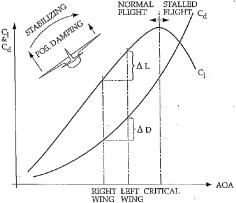
Figure 7: Effects of Left Yaw Input during Normal Flight[6]
Let’s now move into the Stalled Flight regime. Imagine performing a routine, wings-level, one-g stall in a perfectly rigged airplane loaded within its approved limits. Assume we reach critical angle of attack configured as follows: Power at idle, ailerons held neutral, no flaps, excess yaw proactively cancelled, elevator control held fully aft. At the stall, aerodynamic forces and moments try to pitch the nose forward, but no net yawing or rolling is present since we’re perfectly coordinated. Using rudder inputs to remain coordinated throughout the stall compels the left and right wings to remain at identical angles of attack. Consequently, each wing generates equal amounts of Lift and Drag even though they’re both stalled. Stabilizing forces are at work to return the airplane to Normal Flight in this case, and no pro-spin yaw/roll couple is present yet.
Now picture performing another stall similar to the one above, except that we enter Stalled Flight while uncoordinated. In fact, let’s exaggerate matters by intentionally yawing the airplane with full left rudder as the nose pitches forward. As we saw in the Normal Flight example, the airplane yaws left, inducing a left roll. The net relative winds are affected the same as in the Normal Flight example as well, resulting in a greater angle of attack on the left wing and a lower angle of attack on the right. The outcome in the Stalled Flight regime, however, is quite different from that in the Normal Flight regime.
In the Stalled Flight regime, the left wing now experiences a lower coefficient of lift than the right wing; hence, the airplane rolls even farther to the left. This is known as negative damping in roll. A significant differential in Drag to the left exists as well, overpowering any adverse yaw from the roll and contributing additional left yaw. A pro-spin yaw/roll couple forms, spawned by the uncoordinated flight while stalled. Although stalling is a necessary prerequisite to the development of the spin, it clearly is not the prime mover behind it. Excess yaw coupling with roll is the real culprit. Proper coordination, therefore, is paramount for spin prevention and must be a cornerstone of stall/spin awareness.
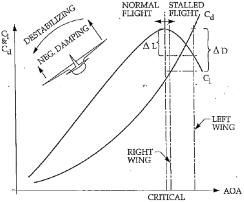
Figure 8: Effects of Left Yaw Input during Stalled Flight[7]
*** End of Excerpt by Rich Stowell: The Light Airplane Pilot’s Guide to Stall/Spin Awareness
AOA Management in ALL Upsets
The importance of AOA management in a stall is obvious to most pilots despite the typical panic response of pulling and making things even worse when close to the ground. However, in nearly every single upset scenario, with the exception of the developed spin and perhaps a nose low dive with wings within 45 degrees of level, AOA is arguably the most time-critical aspect of an effective recovery and must be placed at the very top of the list. Many readers will understandably start shaking their head at this point asserting that sometimes power is first or perhaps stating a configuration change is sometimes the best first step. Let’s address recovery thought processes as we investigate the role of AOA in the delivery of a life-saving upset recovery training course.
What is the biggest threat to survival in the following Case Studies?
Case 1: Any Stall
(Includes; Power-On, Power-Off, Cross-Controlled, Uncoordinated, Slip, Skid, Incipient Spin)
Threat – The stall is the threat. If uncorrected, the stall sustains the aircraft in an out of control flight condition and could quickly lead to an unrecoverable spin if not addressed immediately.
Correction – “PUSH” to reduce AOA (regardless of altitude or attitude) to regain positive normal control of all axis of the aircraft. When AOA is below critical, continue with the All-Attitude Upset Recovery procedure (Table 1).
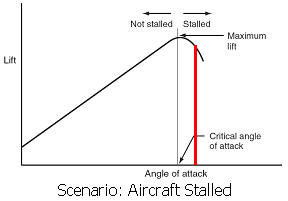
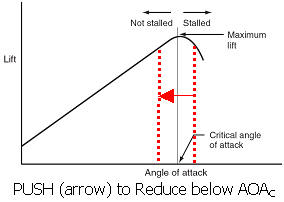
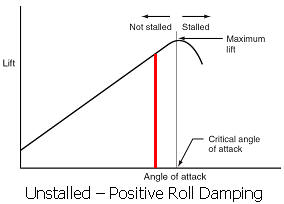
Case 2: Nose High and Nose High Overbank Unusual Attitude (unstalled, airspeed decreasing)
Threat – The nose needs to come down. However, the biggest threat in a nose high flight condition is avoiding a nose-high stall while getting the nose down. An inadvertent stall from a nose-high flight attitude can very quickly lead to the coupling of the stall with the inertial yaw of the nose dropping. Whether we push or pull when nose high, the nose will be coming down. The real question is: “Do you want to be in control as the nose drops or not?”
Correction – “PUSH” to keep AOA well below critical expanding the normal operating envelope of the aircraft, reducing drag, preserving airspeed and optimizing controllability. There is a general misconception in nose-high unusual attitude recoveries that as long as the nose is coming down then there’s nothing to worry about. Keep in mind that whether the pilot is pushing or pulling on the control column, the nose will be coming down (assuming the aircraft does not have sufficient energy to bring the nose over-the-top such as a looping maneuver). The difference is that if the pilot is pulling as the nose drops, the aircraft is most likely stalled and NOT under control. If the pilot is pushing to keep the aircraft’s AOA below critical throughout the recovery then the pilot will always have positive control of the aircraft. When AOA has been reduced with a firm push to a “light in the seat” feeling, continue with the All-Attitude Upset Recovery procedure (Table 1).
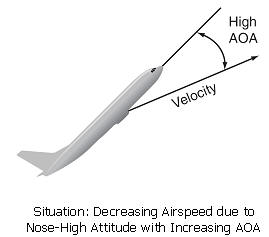

Figure 9: Effectives of Unloading or “PUSHing” in a Nose High Recovery
Case 3: Nose Low and Nose Low Overbank/Inverted (unstalled, airspeed increasing)
(excluding nose-low within 45 degrees of wings level)
Threat – The dive angle continues increasing in an overbank (conceptually think of an inverted flight attitude generated from a severe wake turbulence encounter). There is an immediate requirement to maximize roll rate to get wings level in minimum time. Each second of delay results in dramatic airspeed gain and altitude loss.
Correction – “PUSH” to reduce AOA to:
Minimize the overbanked aircraft’s contribution to the ever-increasing dive angle,
Maximize roll rate, and
Simultaneously eliminate the risk of an inefficient rolling pull that could potentially cause structural damage due to asymmetric loading on the aircraft.
When AOA has been reduced with a firm push to a “light in the seat” feeling, continue with the All-Attitude Upset Recovery procedure (Table 1).

Figure 10: Unload (“PUSH”) to Optimize Recoverability and Minimize Altitude Loss
How Can We Ensure AOA Remains Below Critical
Now that we’ve spent several minutes discussing the importance of managing AOA in all upset situations in addition to stalled flight, an understandable question at this point would be simply “How”? As pilots we are all familiar with stall warning devices that tell us we are getting close to critical angle of attack but AOA indicators are not commonplace in certified aircraft. In fact, we can assume over 99% of certified aircraft DO NOT have AOA indicators.
This presents a problem when our learned advice states “lower the angle of attack”. The importance of lowering angle of attack cannot be under-emphasized.
In summary, the benefits of lowering AOA are:
- Stalled flight is eliminated when lowered below critical AOA, hence, the risk of a spin is also eliminated,
- All controls become more effective (especially ailerons),
- Roll rate using ailerons is maximized,
- The flight envelope is expanded. Meaning the actual stall speed is well below the published stall speed by keeping AOA below critical ensuring positive aircraft control in a low-speed recovery such as in an extreme nose high flight condition,
- In an overbank beyond 90 degrees to inverted, dive angle increase in the subsequent recovery is minimized, and
- Asymmetric loading during the rolling recovery is minimized.
So how do we lower AOA?
The first step in the All-Attitude Upset Recovery procedure is “Push”. How much? How long? How much push is too much?
CL = Coefficient of Lift (a function of AOA – see Figure 12)
? = Relative Air Density
V = True Airspeed of the Aircraft
S = Surface Area of the Wing
As we can see from the lift equation in Figure 11 above, the amount of lift generated by the wing at any time is a function of aircraft velocity, wing area, relative air density and coefficient of lift (a function of AOA as shown in Figure 12). In a time-critical emergency situation like an airplane upset, the only factor we can instantly affect is the coefficient of lift (CL) through the positioning of the elevator control in the cockpit. Directly manipulating the value of CL is the key to effecting the proper “PUSH” in an upset recovery.

Figure 12: Coefficient of Lift (and Drag) with Varying AOA
Our goal in the reduction in Angle of Attack step should be to optimize the coefficient of lift to effectively manage AOA below critical in a stall, optimize roll rate in a nose-low overbank and to expand the flight envelope when nose high. The essence of the issue, however, is being able to practically do it in the airplane. This brings us back to the reality that these types of skills can only be developed through practical experience in a real aircraft with repetition to proficiency. At APS we have several excellent exercises that teach this ability during the initial portion of training. Once the pilot has a feel for how to do it, we then have them implement this technique in a wide variety of scenario-based airplane upset situations.
How
Push the elevator forward until a light positive-G feeling of ¼ to ½ G can be sustained by referencing “seat of the pants”. The amount of forward pressure required to accomplish the proper “PUSH” can vary from a couple of pounds to 20 – 30 pounds of control pressure in a transport category aircraft. Once your butt is calibrated, you now have a tool that can transfer to any fixed wing aircraft.
How Much PUSH is Too Much?
Here’s a simple answer: If your tie is in your face, your pencil is floating off the seat in the aircraft or you’re feeling any pressure on your straps getting pushed off your seat, then you are pushing too much. The target is a light “positive G” not zero-G or negative-G.
Stall Warning Devices
Clearly we do not have an instrument in the cockpit that will tell us when we’ve unloaded to the proper AOA to optimize recovery from unstalled unusual attitudes. Without a device such as an AOA Gauge the proper technique of AOA management can only be learned by practical in-aircraft experience. Having said that, as a military fighter pilot (fighter’s are equipped with AOA gauges) the technique of unloading had to be an ingrained instinct. Unloading usually occurred without reference to the AOA gauge while keeping site of the adversary aircraft (i.e. not looking in the cockpit) was the top priority during aggressive flight attitude and plane of motion changes. Sorry folks – it seems no matter how the aircraft is equipped, we need practice, practice, and more practice to be competent in the management of AOA in the all-attitude environment. This is true even for aircraft that have an AOA gauge.
With that said, stall warning devices are critical to the safe operation of an aircraft in the high AOA (typically low airspeed but not always) environment. Every FAA certified aircraft requires some type of device to give the pilot a warning of the approaching stall. Moreover, as we’ve discussed at length, the pilot’s “awareness” of AOA is the crux of the issue. Unfortunately, with the exception of military fighter aircraft, the vast majority of GA and commercial aircraft are not equipped with any direct method of reading the aircraft’s AOA at any given time. We’re typically limited to whatever stall warning device the manufacturer decides to install.
For ease of reference, below is a list of common wing-design features and stall-warning indicators that are intended to improve aircraft controllability and AOA awareness in high AOA flight.
Excerpted from the Internet[8]:
Airplanes can be equipped with a variety of devices to prevent or postpone a stall or to make it less (or in some cases more) severe, or to make recovery easier.
- An aerodynamic twist can be introduced to the wing with the leading edge near the wing tip twisted downward. This is called washout and causes the wing root to stall before the wing tip. This makes the stall gentle and progressive. Since the stall is delayed at the wing tips, where the ailerons are, roll control is maintained when the stall begins.
- A stall strip is a small sharp-edged device which, when attached to the leading edge of a wing, encourages the stall to start there in preference to any other location on the wing. If attached close to the wing root it makes the stall gentle and progressive; if attached near the wing tip it encourages the aircraft to either drop a wing when stalling or act as an aerodynamic barrier to the stall propagation along the inner portion of the wing typically at higher angle of attack.
- Vortex generators, tiny strips of metal or plastic placed on top of the wing near the leading edge that protrude past the boundary layer into the free stream. As the name implies they energize the boundary layer by mixing free stream airflow with boundary layer flow thereby creating vortices, this increases the inertia of the boundary layer. By increasing the inertia of the boundary layer airflow separation and the resulting stall may be delayed.
- An anti-stall strake is a wing extension at the root leading edge which generates a vortex on the wing upper surface to postpone the stall.
- A stick pusher is a mechanical device which prevents the pilot from stalling an airplane by pushing the controls forwards as the stall is approached.
- A stick shaker is a mechanical device which “shakes the pilot’s controls” to warn of the onset of stall.
- A stall warning is an electronic or mechanical device which sounds an audible warning as the stall speed is approached. The majority of aircraft contain some form of this device that warns the pilot of an impending stall. The simplest such device is a ‘stall warning horn’, which consists of either a pressure sensor or a movable metal tab that actuates a switch, and produces an audible warning in response.
- An angle of attack limiter or an “alpha” limiter is a flight computer that automatically prevents pilot input from causing the plane to rise over the stall angle. Some alpha limiters can be disabled by the pilot.
- If a forward canard is used for pitch control, rather than an aft tail, the canard is designed to meet the airflow at a slightly greater angle of attack than the wing. Therefore, when the aircraft pitch increases abnormally, the canard will usually stall first, causing the nose to drop and so preventing the wing from reaching its critical AOA. Thus the wing virtually never stalls.
- If an aft tail is used, the wing is designed to stall before the tail. In this case, the wing can be flown at higher lift coefficient (closer to stall) to produce more overall lift.
- Stall warning devices such as stall lights, horns and shakers give the pilot a stall warning ~5 kts or 5% above the CAS stall speed, whichever is greater. Typically this assumes an approach-to-stall airspeed reduction of one knot per second or less. Other conditions exist based on aircraft design and category but the concept is to allow the pilot to respond with a reasonable delay of a few seconds and still recover the aircraft prior to reaching the actual aerodynamic stall.
***End of Excerpt***
Recovery Technique Development
Our primary concern at APS Emergency Maneuver Training is to ensure the academics and recovery techniques we teach are directly transferable to a wide variety of fixed wing aircraft from the Cessna 172 to Boeing and Airbus transport category aircraft. That is a tall order. With this mandate in place, we ensure each member of our check airman staff has first-hand experience in each major category of aviation that assures a thoroughly rounded knowledge in all of; general aviation aircraft handling, recreational aerobatics, high performance military jet aircraft all-attitude maneuvering and transport category aircraft performance characteristics. We can’t over-emphasize the critical importance of ensuring that experts with rounded experience in all these fields quarterback the development of recovery techniques.
With that being said, are we trying to say pilots can’t learn effective recovery techniques unless they have all this varied aircraft experience under our belts? “NO” we are not saying that at all. Every single pilot, regardless of experience level, can be taught effective recovery techniques that can be engrained into their pilot skill set in a matter of days. Using safe aerobatic aircraft while being instructed by highly experienced upset recovery instructors are the keys to obtaining proper recovery skills as a pilot.
Keep in mind: Upset recovery piloting skills are perishable and there is no substitute for hands-on experience in real aircraft recovering from extreme upset scenarios. Recurrent training is important on an annual basis to ensure recovery techniques are readily accessible in a time critical situation. Proper academic and practical training combined with a healthy dose of de-programming to get rid of ineffective recovery habits produces pilots capable of dealing with just about any possible upset the environment can throw at them.
Safe journeys to all!
[1] Dave Carbaugh and Larry Rockliff, FAA Airplane Upset Recovery Training Aid – Revision 1, Federal Aviation Administration, August 2004, 2.18
[2] Carbaugh and Rockliff, 2.18
[3] Carbaugh and Rockliff, pg ix
[4] Carbaugh and Rockliff, 2.19
[5] Carbaugh and Rockliff, 2.20
[6] Rich Stowell, The Light Airplanes Pilot’s Guide to Stall/Spin Awareness, (Ventura: Rich Stowell Consulting, 2007), 228.
[7] Stowell, 229.
[8] Wikipedia: Stall (Flight), http://en.wikipedia.org/wiki/Stall_(flight)#Stall_warning_and_safety_devices (5 Jan 08)
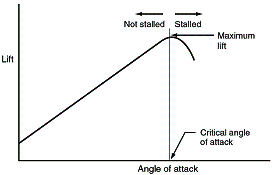

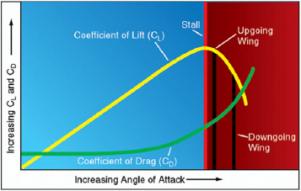
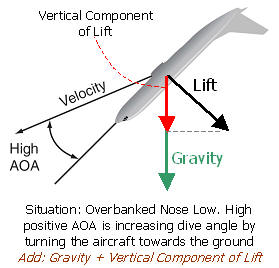

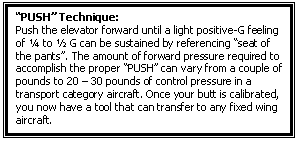




Comments: